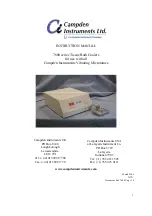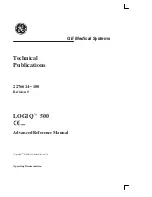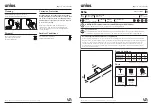
WavePro 7Zi
427
WP700Zi-OM-E-RevA
described by equation 1 is fitted to the measured curve by selecting the Rj (slope) and Dj (intercept) to minimize
the error in the fit.
The second method of fitting Rj and Dj to the measured data is based on direct measurements of the
deterministic jitter. Random jitter is the difference between this value and the total jitter at the selected bit error
rate measured from the total jitter curve. This, of course, exactly matches the measured total jitter at the selected
bit error rate, but is a poor predictor of the jitter for bit error rates below this level. The motivation behind
employing this method is to better represent the contribution of deterministic jitter in the overall jitter at the
specified bit error rate.
Each method of measuring Rj and Dj results in different values for the standard deviation and spacing between
the Gaussian curves in the distribution in
Figure 7
. The total jitter at the specified bit error rate, however, is the
same for either distribution.
Effective Random and Deterministic Jitter
The effective jitter components Rje and Dje represent the best fit values for equation 1 to the behavior of the
measured total jitter as the observation time is increased or, equivalently, the bit error rate is decreased. For a
given bit error rate, the total jitter is measured from the width of the total jitter curve. The value of the total jitter as
the bit error rate is decreased can be plotted as shown in
Figure 13
. The vertical axis of the plot on the left is the
log of bit error rate. The Gaussian nature of the jitter at the extremes of the distribution results in a total jitter that
grows approximately linearly with the log of BER, as shown in the upper curve in the plot on the right. The
function N(BER) in equation 1 represents the width of a normal distribution with a variance of one at a given
confidence level equal to 1-BER. The lower curve on the plot on the right shows the variation of N(BER) with the
log of BER which is approximately linear. The values of Rje and Dje are chosen so that the lower curve lies on top
of the upper one. From equation 1, it can be seen that Rje is a slope parameter while Dje adjusts the intercept
point.
Figure 5-42. The change in total jitter with BER is represented by the values Tjn in the total jitter curve on
the left. These values are plotted vs. bit error rate in the upper line in the chart on the right while the lower
line shows the variation vs. BER for a pure Gaussian. Rje and Dje are chosen such that the curves line
up.
The jitter computed using this method allows equation 1 to accurately model the jitter behavior of systems as a
function of bit error rate. This model is especially useful when computing jitter margins in system applications.
Direct Measurement of Deterministic Jitter
Deterministic jitter can be completely characterized by measuring the threshold crossing times of the data signal
over a finite time period. The two classes of deterministic jitter are periodic and data dependent.
Data dependent jitter is caused by system effects that are dependent on the data pattern. A common source of
data dependent jitter is the frequency response of the channel through which the serial data signal is transmitted.
In this case, data patterns with many transitions (such as a 101010… pattern) contain more high frequencies in
their spectrum than patterns containing fewer transitions (11001100…, for example). The patterns with higher
frequency content will be attenuated and phase shifted relative to the lower frequency patterns. In addition to data
dependent jitter, the rise and fall times of the data bits can be different. The detection threshold in the receiver is
normally set to the 50% amplitude (midway between the “1” and “0” levels) so unequal rise and fall times will
generate jitter. This type of jitter is known as Duty Cycle Distortion (DCD).
When
DDj Calc. Method
is set to
ISI Plot
, the SDA uses a patent-pending method to measure both forms of data
dependent jitter. The method uses the history of a number of bits in the waveform to determine their effect on the
Содержание DDA 7 Zi series
Страница 1: ...Operator s Manual WavePro SDA and DDA 7 Zi Series Oscilloscopes ...
Страница 2: ... L R R H HUD RU D D ...
Страница 41: ...Operator s Manual WP700Zi OM E RevA 40 The detachable WavePro Zi front panel ...
Страница 376: ...WavePro 7Zi 375 WP700Zi OM E RevA Absolute Offset Relative ...
Страница 439: ...Operator s Manual WP700Zi OM E RevA 438 ...
Страница 440: ...WavePro 7Zi 439 WP700Zi OM E RevA ...
Страница 544: ...Thank you for purchasing a WavePro SDA or DDA 7 Zi Oscilloscope ...
















































